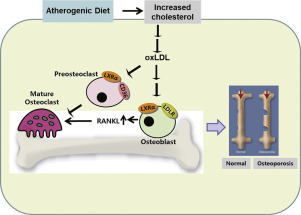The Journal of Nutritional Biochemistry ( IF 4.8 ) Pub Date : 2020-01-08 , DOI: 10.1016/j.jnutbio.2019.108337 Ok-Joo Sul 1 , Ji-Eun Kim 1 , Ke Ke 1 , Jae-Hee Suh 2 , Hye-Seon Choi 1

|
Atherogenic diet (AD) decreased bone density and increased serum cholesterol level in male mice, implying that cholesterol participates in bone loss. The aim of the present study was to identify the cells responsible for bone loss and evaluate the involved mechanism. AD resulted in increased number and surface of osteoclasts (OCs) with in vivo tartrate-resistant acid phosphatase (TRAP) staining, suggesting a critical role of OCs in cholesterol-induced bone loss. In vitro, cholesterol loading by oxidized low-density lipoprotein (oxLDL) increased the size and number of OCs as well as bone resorption activity, suggesting that cholesterol loading affects the number and activity of OCs. In contrast, cholesterol depletion by simvastatin decreased osteoclastogenesis and bone resorption. oxLDL stimulated osteoblasts (OBs) to increase expression of receptor activator of nuclear factor kappa-Β ligand (RANKL), resulting in increased OC formation when OBs were co-cultured with bone marrow derived macrophages. oxLDL increased expression of CD36 and liver X receptors (LXRα) in OCs as well as low density lipoprotein receptor (LDLR) and LXRα in OBs. These results suggest that CD36 and LXRα mediate the effect of oxLDL in OCs, whereas LDLR and LXRα mediate the effect of oxLDL in OBs. These findings demonstrate cholesterol-induced bone loss with increasing number and activity of OCs in mice, suggesting another harmful effect of cholesterol, a major cause of atherosclerosis.
中文翻译:

节食性饮食引起的骨质流失主要归因于小鼠破骨细胞增多。
致动脉性饮食(AD)降低了雄性小鼠的骨密度并增加了血清胆固醇水平,这暗示胆固醇参与了骨质流失。本研究的目的是鉴定造成骨丢失的细胞并评估其参与的机制。AD体内抗酒石酸盐酸性磷酸酶(TRAP)染色导致破骨细胞(OCs)的数量和表面增加,表明OCs在胆固醇诱导的骨质流失中起关键作用。在体外,通过氧化的低密度脂蛋白(oxLDL)负载的胆固醇增加了OC的大小和数量以及骨骼的吸收活性,这表明胆固醇负载会影响OC的数量和活性。相反,辛伐他汀消耗胆固醇会降低破骨细胞生成和骨吸收。oxLDL刺激成骨细胞(OBs)以增加核因子kappa-Β配体(RANKL)受体激活剂的表达,当OBs与骨髓来源的巨噬细胞共培养时,导致OC形成增加。oxLDL增加了OC中CD36和肝X受体(LXRα)的表达以及OB中低密度脂蛋白受体(LDLR)和LXRα的表达。这些结果表明,CD36和LXRα在OC中介导oxLDL的作用,而LDLR和LXRα在OB中介导oxLDL的作用。这些发现表明,随着小鼠中OC数量和活性的增加,胆固醇诱发的骨质流失,表明胆固醇的另一有害作用,这是动脉粥样硬化的主要原因。oxLDL增加了OC中CD36和肝X受体(LXRα)的表达以及OB中低密度脂蛋白受体(LDLR)和LXRα的表达。这些结果表明,CD36和LXRα在OC中介导oxLDL的作用,而LDLR和LXRα在OB中介导oxLDL的作用。这些发现表明,随着小鼠中OC数量和活性的增加,胆固醇诱发的骨质流失,表明胆固醇的另一种有害作用,这是动脉粥样硬化的主要原因。oxLDL增加了OC中CD36和肝X受体(LXRα)的表达以及OB中低密度脂蛋白受体(LDLR)和LXRα的表达。这些结果表明,CD36和LXRα在OC中介导oxLDL的作用,而LDLR和LXRα在OB中介导oxLDL的作用。这些发现表明,随着小鼠中OC数量和活性的增加,胆固醇诱发的骨质流失,表明胆固醇的另一有害作用,这是动脉粥样硬化的主要原因。










































 京公网安备 11010802027423号
京公网安备 11010802027423号